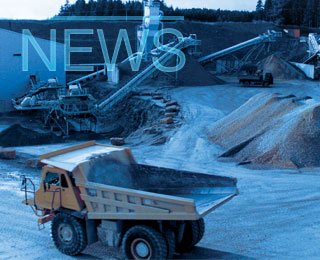The first-quarter 2012 reporting season has seen a harsh winter dampen construction activity in Europe for the leading global cement majors but overall an improving tone has begun to emerge. Cost reduction measures and targeted price increases appear to be key themes as producers look to improve margins in the second half of this year.
European weather bites, emerging markets lead the way
As usual, the impact of weather conditions has featured significantly in first-quarter results but this time with contrasting trends. While Europe suffered from a big chill in February, the US recorded its mildest 1Q in history. Europe has indeed remained challenging, largely due to economic difficulties in southern regions as well as the negative weather effect leading to softer volumes after an unusually mild winter last year. All the leading global players reported first-quarter declines in Northern and Western European in terms of turnover and deliveries. Heidelberg did report advances in its Eastern Europe & Central Asia division and Holcim said cement volumes were just 2.2% lower in emerging markets in Europe compared with a 20% drop in mature markets.
Elsewhere, Holcim said Asia and Latin America continued to drive demand as was the case for a number of leading players. Indonesia proved to be a particular hotspot for HeidelbergCement while Brazil reinforced its position as Cimpor’s star performer, contributing 44% of first-quarter EBITDA. For Lafarge, Africa also proved to be a driver of first-quarter growth with double-digit volume increases in Nigeria, Kenya and South Africa.
Signs of an upturn in North America have also proved encouraging. Cemex said that March 2012 marked the eighth consecutive rise in US cement volumes thanks to favourable weather and higher residential, industrial and commercial demand. For Titan, the US was the largest contributor to 1Q turnover. Advances were also generally seen across the board in the Middle East and Africa, indicating that the slowdown from the Arab Spring is lifting, although trading conditions in Egypt still remain volatile as the political situation is still very uncertain. Lafarge’s volumes in Egypt increased by 2% with a positive trend in pricing but Vicat reported 30% decline in volumes for the quarter, while Titan Cement saw demand edging upwards.
Going forward, emerging markets in Asia and Latin America are seen to continue being the main drivers of demand and slight improvements are also expected in North America. Holcim has said demand in Europe “should remain stable, provided that the situation is not undermined by further systemic shocks.” The Swiss major has forecasts growth in Russia and Azerbaijan in 2012. HeidelbergCement also expects further advances in Eastern Europe-Central Asia. Lafarge reconfirmed its forecast for global cement demand to improve by 1-4% while Cemex sees growth of 2% in full-year cement sales.
Cost-cutting focus
For all cement makers, cost-cutting is now a priority as producers aim to beat sluggish demand in Europe and offset rising input costs. During its first-quarter commentary Holcim, now under the helm of new CEO Bernard Fontana, placed particular emphasis on deepening cuts to drive profitability. The group says it plans to introduce a new programme next week, stating: "The aim is to significantly improve operating profit and therefore to support a higher return on invested capital.” This cost-cutting culture also saw Lafarge slash €70m in the first quarter towards its €400m reduction target in 2012 and the group has also said it is pushing forward to meet a target of selling €1bn in assets. Meanwhile, HeidelbergCement’s “FOX 2013” programme has led the group to a 1Q12 improvement in cash flow of €39m and the group says it is well on track to achieving the targeted improvement of €850m over the three-year horizon. In 2011, the programme already generated cash-effective savings totaling €384m.
Improving margins
Encouraging signs have led analysts to predict a recovery in 2H11 cement margins which suffered last year on the back of rapidly-rising energy prices. However, recent declines in coal and petcoke costs (detailed in last week’s CemNet newsletter) coupled with cement price increases have helped to compensate for the cost of inputs. Energy costs are expected to continue to rise, albeit at a slower pace and Cemex said it expects cost of energy on a per tonne-basis to decline by about 2%. In the 1Q Holcim reported +5% cement price growth at the group level and commented that it was "able to mostly pass on cost increases through higher sales prices in all segments and in all Group regions, with the exception of Africa Middle East." Lafarge reported improved pricing across all product lines in the 1Q12 and said it expects higher pricing for the year.
Better pricing conditions are generally expected and recent commentary from Bernstein Research states: “Margin recovery is, in our view, inevitable given the current trends in international energy costs and ongoing pricing strength, and we believe that the time at which these will start to be translated into margins is rapidly approaching.”
